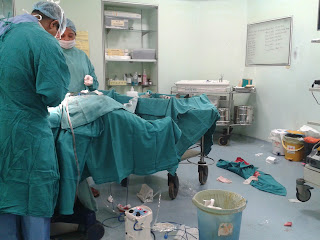I have moved from the emergency department to operating theatres in Delhi.
The first thing you notice in this hospital is that some of the theatres operate with their corridor doors open. In the UK each theatre has an anaesthetic room leading to theatre and you need to pass through 2 doors (which shouldn't both be open at once) to get into the theatre. There are also only 2 sinks in the corridor to scrub up in, whereas in the UK each theatre has a sink inside for you to do this.
 |
| Inside an Indian operating theatre |
I am also in awe of the respect shown between the staff. Nurses are frequent called sister or brother, whilst Dr's are called sir or ma'am. I think this is amazing as in the UK we often call each other by first names, or you just hear the terms nurse or Dr. This respectful culture is definitely one that I think is great, especially as I am not a fan of being referred to as 'nurse' when I am at work. However, the hierarchy in theatres is clear - the Dr's have a spacious lounge, whilst the nurses have something near to a shoe box with curtains to change behind and a table in the middle. The nurses also have a different coloured uniform to the Drs, which I think is actually quite useful as in the UK often everyone in theatres is dressed the same, making it impossible to tell who is who.
I have been privileged to see several caesarean sections, including one for twins. I have also had some brilliant surgeons explain what they are doing along with others that work in complete silence. There is a separate little room in theatres with the incubator table and neonatal equipment.
I have seen a lot of laparascopic procedures which has been interesting. Mesh for a hernia repair costs 43000 rupees.
There is also a pharmacy in theatres. I assume that alongside the cost of your procedure, any drug used is obtained from pharmacy and added to the bill. There are no real stock of drugs or dressings in the theatre itself, everything comes from pharmacy. Most wound dressings are just gauze and mepore rather than complex or waterproof as in the UK. Anything additional to your procedure is added up - each bottle of saline and each vial of antibiotics. Most people seem to be cash patients, rather than under any insurance.
You can also be operated on a lot quicker - one patient had only presented to outpatients an hour before she was having her procedure in theatres. Otherwise clinically things are relatively similar to practice in the UK, just in a very different environment. Next week I am headed to MRI/CT so I can look at pretty images
 |
| The neonatal room |
I have seen a lot of laparascopic procedures which has been interesting. Mesh for a hernia repair costs 43000 rupees.
There is also a pharmacy in theatres. I assume that alongside the cost of your procedure, any drug used is obtained from pharmacy and added to the bill. There are no real stock of drugs or dressings in the theatre itself, everything comes from pharmacy. Most wound dressings are just gauze and mepore rather than complex or waterproof as in the UK. Anything additional to your procedure is added up - each bottle of saline and each vial of antibiotics. Most people seem to be cash patients, rather than under any insurance.
You can also be operated on a lot quicker - one patient had only presented to outpatients an hour before she was having her procedure in theatres. Otherwise clinically things are relatively similar to practice in the UK, just in a very different environment. Next week I am headed to MRI/CT so I can look at pretty images
No comments:
Post a Comment